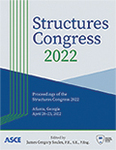The Statistical History of US Tornadoes
Publication: Structures Congress 2022
ABSTRACT
As engineers, we all know that tornadoes are violent but rare wind events. Beginning with ASCE 7-22, limited tornado design appears in the code. But is there more to tornado design than “Basic Wind Speed” and “Exposure?” Let’s look at the historic records of US tornadoes, from the standpoint of probabilistic design, to see what we can learn about these devastating storms, common to much of our country. Just as earthquake damage involves more than acceleration and soil type, tornadoes have different sizes, duration, velocities, and these characteristics affect damage and risk to human life. We will address topics based on recorded tornado data: (1) How do tornadoes function? (2) Is the diameter of severe tornadoes larger or smaller than minor tornadoes? (3) Historically, how common are devastating tornadoes? (4) How can we build more tornado resistant structures for a reasonable economic cost? (5) What is the best method of protecting human life in tornadoes?
Get full access to this article
View all available purchase options and get full access to this chapter.
REFERENCES
Agee, E., and Childs, S. (2014). “Adjustments in tornado counts, F-scale intensity, and path width for assessing significant tornado destruction.” Journal of Applied Meteorology and Climatology, 53(6), 1494–1505.
Brooks, H. E. (2004). “On the relationship of tornado path length and width to intensity.” Weather and forecasting, 19(2), 310–319.
Brooks, H. E., Doswell, C. A., and Kay, M. P. (2003). “Climatological estimates of local daily tornado probability for the United States.” 18, 626–640.
Cobeen, K. E., Russell, J., and Dolan, J. D. (2004). Recommendations for earthquake resistance in the design and construction of woodframe buildings. Consortium of Universities for Research in Earthquake Engineering.
Coleman, T. A., Knupp, K. R., Spann, J., Elliott, J. B., and Peters, B. E. (2011). “The history (and future) of tornado warning dissemination in the United States.” Bulletin of the American Meteorological Society, 92(5), 567–582.
Doswell, C. A., Brooks, H. E., and Dotzek, N. (2009). “On the implementation of the enhanced Fujita scale in the USA.” Atmospheric Research, 93(1), 554–563 4th European Conference on Severe Storms.
Dotzek, N., Grieser, J., and Brooks, H. E. (2003). “Statistical modeling of tornado intensity distributions.” Atmospheric research, 67, 163–187.
Fujita, T. T. (1971). “Proposed characterization of tornadoes and hurricanes by area and intensity.”.
Grazulis, T. P. (1993). “A 110-year perspective of significant tornadoes.” Washington DC American Geophysical Union Geophysical Monograph Series, 79, 467–474.
McCarthy, D. W. (2003). NWS tornado surveys and the impact on the national tornado database.
McDonald, J. R., and Mehta, K. C. (2006). A recommendation for an enhanced Fujita scale (EF-scale). Wind Science and Engineering Center, Texas Tech University.
National Weather Service. (2021). “Convective parameters”, <https://www.weather.gov/fwd/convectiveparameters> (November).
NOAA. (2021). “Enhanced F scale for tornado damage, <https://www.spc.noaa.gov/efscale/ef-scale.html>.
Schaefer, J. T., and Edwards, R. (1999). “The SPC tornado/severe thunderstorm database.” Preprints, 11th Conf. on Applied Climatology, Dallas, TX, Amer. Meteor. Soc, Vol. 6.
Varaksin, A. Y. (2017). “Air tornado-like vortices: Mathematical modeling (a review).” High Temperature, 55(2), 286–309.
Information & Authors
Information
Published In
History
Published online: Apr 18, 2022
Authors
Metrics & Citations
Metrics
Citations
Download citation
If you have the appropriate software installed, you can download article citation data to the citation manager of your choice. Simply select your manager software from the list below and click Download.
